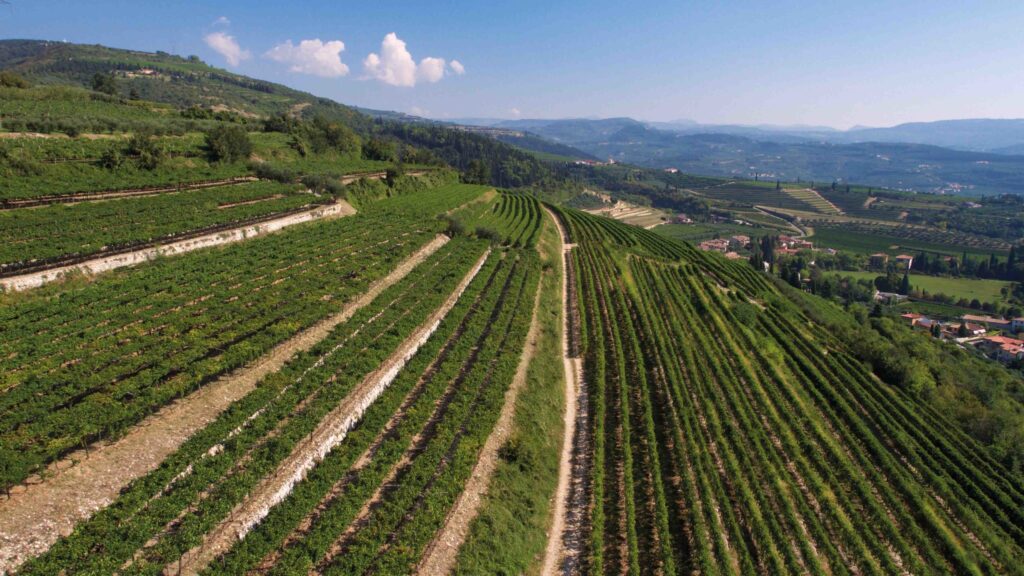
Valpolicella gets a bad rap. If they think of it at all, most people think Valpolicella is a cheap supermarket wine. And with good reason, because the oceans of low quality Valpolicella that were produced in the ‘70s and ‘80s continue to tarnish its reputation. There has been a renewed recent focus on distinctive, high-quality wines, however, and today Valpolicella may just be one of Italy’s most underrated wines.
- Mind you, there’s still plenty of mediocre Valpolicella to be found. A bottle of basic Bolla Valpolicella (my “go to” wine in the ‘80s, when my wine budget and knowledge were equally deficient) can be had for $7.
Valpolicella (“valley of many cellars”) is the name of an appellation in northeast Italy, in the Veneto region. It contains a smaller, original “Valpolicella Classico” zone, which tends to produce higher quality wines. Valpolicella wine is made from a blend of indigenous grapes, predominantly Corvina but also Molinara and Rondinella.
- If you said, “Huh?” when you saw those grape names, you’re in good company. That’s part of Valpolicella’s image problem. Unlike a Cabernet, where you know what to expect, Corvina can be a mystery.
There are several distinct styles of Valpolicella, all made from the same grapes.
- Basic Valpolicella is a lightweight, undistinguished wine that can be made from grapes grown anywhere in the appellation. Valpolicella “Classico” comes from a smaller zone and is often higher quality.
- Valpolicella Classico Superiore is a step up on the quality ladder. It’s made from better grapes, aged at least a year, and has a slightly higher alcohol level and greater complexity. Compared to basic Valpolicella, it’s richer, minerally, and has more enticing dried cherry and licorice notes.
- Valpolicella Ripasso is more intensely flavored, tannic, and fuller-bodied. It’s made by the refermentation of basic Valpolicella wine on Amarone pomace (leftover skins and seeds), hence its nickname of “baby Amarone.” A good example is Masi Campo Fiorin.
- Amarone Della Valpolicella is consider to be the greatest traditional wine of northern Italy. It’s a dry, full-bodied, richly fruited wine made from grapes that have been left hanging on vine longer to achieve extra ripeness. After harvest, the grapes are dried for three to four months to further concentrate the sugar and flavors.
- Recioto della Valpolicella is a sweet wine with flavors of raisin, figs, dried cherry, and spice. (Black forest cake, anyone?) It’s produced the same way as Amarone, but fermentation is stopped before all of the sugar is converted to alcohol, leaving a luscious, sweet wine.
Our wine of the week is a 2017 Mazzi Valpolicella Classico Superiore ($28 retail). The wine is made from 70 percent Corvina, 20 percent Rondinella, and 10 percent Molinara, all from the historic Poeiga vineyard located in the hills of the Classico zone. The grapes are dried for 40 days, fermented in stainless steel, then aged in used French-oak barriques for 18 months and another 6 months in the bottle.
- We really enjoyed this wine. It’s garnet colored, with aromas of black cherry, spice, and earth. On the palate, it’s medium bodied, with pleasant dusty tannins and notes of black fruit, spice, and cocoa. The wine is well-balanced, with an intriguing complexity and a long, pleasant finish.
- Mazzi makes only 7,000 bottles annually, so it can be a little hard to find. (Austin readers can find it at Austin Wine Merchant). Other good Valpolicella Classico Superiore producers include Masi, Tommasi, and Allegrini.
- Valpolicella is very flexible with food. Try it with charcuterie, pasta, meat pizza, roasted or fried chicken, or light beef dishes.
Cheers!
